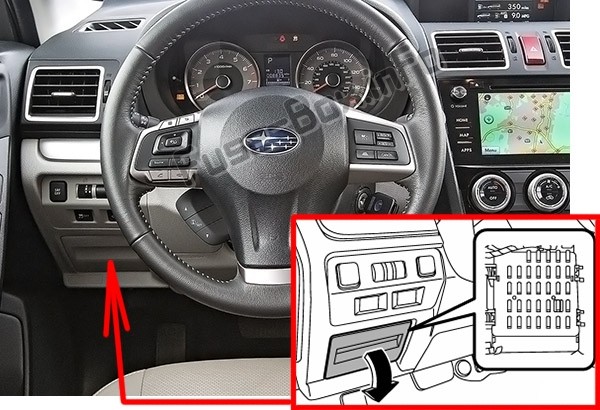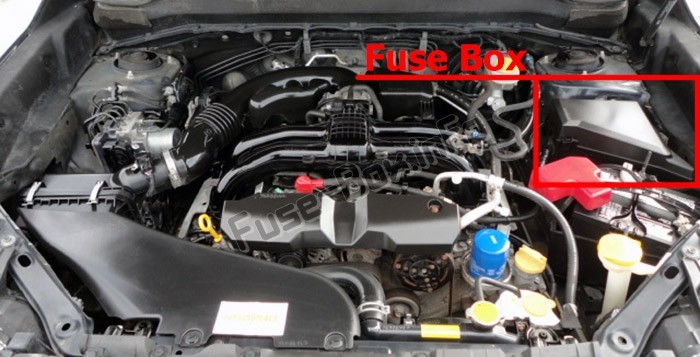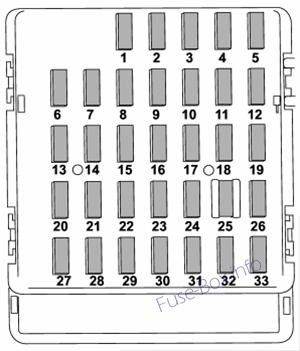Understanding your 2014 Subaru Forester’s fuse box is crucial for basic maintenance and troubleshooting. Whether you’re diagnosing an engine issue with an OBD2 scanner or simply trying to power an accessory, knowing the fuse locations can save you time and hassle. This guide will specifically focus on the 2014 Subaru Forester Obd2 Fuse Location and provide comprehensive information about the fuse box diagrams for models produced between 2013 and 2018 (SJ generation).
Locating the Fuse Boxes in Your Subaru Forester (2013-2018)
Your 2014 Subaru Forester, part of the SJ generation (2013-2018), houses fuse boxes in two primary locations: the passenger compartment and the engine compartment. Knowing where to find each is the first step in addressing any electrical issues or locating the OBD2 fuse location if you are experiencing problems with your diagnostic port.
Interior Fuse Box Location
The primary fuse box you’ll likely access for interior electrical components and potentially the 2014 Subaru Forester OBD2 fuse location is situated inside the passenger compartment.
Specifically, to find the interior fuse box:
- Locate the panel to the left of the steering wheel. It’s usually at knee level for the driver.
- Identify a small notch or tab on the edge of the panel cover.
- Gently pry or pull the cover to remove it and expose the fuse box.
This interior fuse box is where you’ll find fuses for various systems within the cabin, including accessory power outlets, lighting, and potentially circuits related to the OBD2 port.
Engine Compartment Fuse Box Location
For fuses related to engine management, headlights, and other critical vehicle systems, you’ll need to access the fuse box located in the engine compartment.
To access the engine compartment fuse box:
- Open the hood of your Subaru Forester.
- Locate the fuse box, typically positioned near the battery or along the inner fender. It’s usually a black plastic box with a clearly marked cover.
- Unhook the clips or latches securing the fuse box cover to open it and reveal the fuses inside.
This fuse box houses higher amperage fuses and relays that protect circuits vital to the engine and vehicle operation. While less likely to house the direct 2014 Subaru Forester OBD2 fuse, understanding its location is important for overall vehicle electrical system knowledge.
Fuse Box Diagrams and Fuse Assignments (2013-2016 Models)
For the 2013, 2014, 2015, and 2016 Subaru Forester models (early SJ generation), the fuse layouts are consistent. Below are the diagrams and tables detailing the fuse assignments for both the instrument panel (interior) and engine compartment fuse boxes.
Instrument Panel Fuse Box Diagram (2013-2016)
Looking at the diagram and the corresponding table below, we can identify potential fuses related to the OBD2 port. OBD2 ports require power to operate, and in many vehicles, they are often linked to the accessory power outlet circuit.
Instrument Panel Fuse Assignments (2014, 2015, 2016)
| № | Amp Rating | Circuit |
|---|---|---|
| 1 | 20A | Trailer hitch connector |
| 2 | Empty | |
| 3 | 15A | Door locking |
| 4 | 10A | Front wiper deicer relay |
| 5 | 10A | Combination meter |
| 6 | 7.5A | Remote control rear view mirrors, Seat heater relay |
| 7 | 15A | Combination meter, Integrated unit |
| 8 | 15A | Stop light |
| 9 | 15A | Front wiper deicer |
| 10 | 7.5A | Power supply (battery) |
| 11 | 7.5A | Turn signal unit |
| 12 | 15A | Transmission control unit, Engine control unit, Integrated unit |
| 13 | 20A | Accessory power outlet (center console) |
| 14 | 15A | Parking light, Tail light, Rear combination light |
| 15 | 10A | Luggage light, Keyless unit |
| 16 | 7.5A | Illumination |
| 17 | 15A | Seat heaters |
| 18 | 10A | Backup light |
| 19 | 7.5A | Daytime running lights |
| 20 | 10A | Accessory power outlet (instrument panel) |
| 21 | 7.5A | Starter relay |
| 22 | 10A | Air conditioner, Rear window defogger relay coil |
| 23 | Empty | |
| 24 | 10A | Audio unit, Navigation system (if equipped) |
| 25 | 15A | SRS airbag system |
| 26 | 7.5A | Power window relay, Radiator main fan relay |
| 27 | 15A | Blower fan |
| 28 | 15A | Blower fan |
| 29 | 15A | Fog light |
| 30 | Empty | |
| 31 | 7.5A | Auto air conditioner unit, Integrated unit |
| 32 | 7.5A | Clutch switch, Steering lock control unit |
| 33 | 7.5A | Vehicle Dynamics Control unit |




Based on common automotive practices, fuses #13 (20A – Accessory power outlet (center console)) and #20 (10A – Accessory power outlet (instrument panel)) are strong candidates for powering the OBD2 port in your 2014 Subaru Forester. The OBD2 port is often powered through the same circuit as the cigarette lighter or accessory outlets.
Engine Compartment Fuse Box Diagram (2013-2016)
The engine compartment fuse box primarily protects engine and drivetrain related systems. It is less likely to contain the 2014 Subaru Forester OBD2 fuse.
Engine Compartment Fuse Assignments (2014, 2015, 2016)
| № | Amp Rating | Circuit |
|---|---|---|
| A | Main fuse | |
| 1 | 30A | ABS unit, Vehicle Dynamics Control unit |
| 2 | 25A | Main fan (cooling fan) |
| 3 | 25A | Sub fan (cooling fan) |
| 4 | Empty | |
| 5 | 25A | Audio |
| 6 | 30A | Headlight (low beam) |
| 7 | 15A | Headlight (high beam) |
| 8 | 20A | Back-up |
| 9 | 15A | Horn |
| 10 | 25A | Rear window defogger, Mirror heater |
| 11 | 20A | Fuel pump |
| 12 | 20A | Continuously variable transmission control unit |
| 13 | 7.5 A | Engine control unit |
| 14 | 15A | Turn and hazard warning flasher |
| 15 | 15A | Tail and illumination relay |
| 16 | 7.5 A | Alternator |
| 17 | Empty | |
| 18 | Empty | |
| 19 | 15A | Headlight (low beam – right hand) |
| 20 | 15A | Headlight (low beam – left hand) |
Fuse Box Diagrams and Fuse Assignments (2017-2018 Models)
For the later SJ generation Subaru Forester models produced in 2017 and 2018, there are slight variations in the instrument panel fuse layout. The engine compartment layout remains the same.
Instrument Panel Fuse Box Diagram (2017-2018)
While the diagram image is the same as the earlier model years (likely a visual placeholder in the original source), the fuse assignments table reflects changes for the 2017 and 2018 models.
Instrument Panel Fuse Assignments (2017, 2018)
| № | Amp Rating | Circuit |
|---|---|---|
| 1 | 20A | Trailer hitch connector |
| 2 | 15A | Rear seat heater |
| 3 | 15A | Door locking |
| 4 | 10A | Front wiper deicer relay |
| 5 | 10A | Combination meter |
| 6 | 7.5A | Remote control rear view mirrors, Seat heater relay |
| 7 | 15A | Combination meter, Integrated unit |
| 8 | 10A | Stop light |
| 9 | 15A | Front wiper deicer |
| 10 | 7.5A | D-OP +B |
| 11 | 7.5A | Turn signal unit |
| 12 | 15A | Transmission control unit, Engine control unit, Integrated unit |
| 13 | 20A | Accessory power outlet (center console) |
| 14 | 15A | Parking light, Tail light, Rear combination light |
| 15 | 10A | Luggage light, Keyless unit |
| 16 | 7.5A | Illumination |
| 17 | 15A | Seat heaters |
| 18 | 10A | Backup light |
| 19 | 7.5A | Wiper relay |
| 20 | 10A | Accessory power outlet (instrument panel) |
| 21 | 10A | Starter relay |
| 22 | 7.5A | Air conditioner, Rear window defogger relay coil |
| 23 | Empty | |
| 24 | 10A | Audio unit, Navigation system (if equipped) |
| 25 | 15A | SRS airbag system |
| 26 | Empty | |
| 27 | 15A | Blower fan |
| 28 | 15A | Blower fan |
| 29 | 15A | Fog light |
| 30 | Empty | |
| 31 | 7.5A | Auto air conditioner unit, Integrated unit |
| 32 | 7.5A | Clutch switch, Steering lock control unit |
| 33 | 7.5A | Vehicle Dynamics Control unit |
For 2017 and 2018 models, fuses #13 and #20 continue to be the primary suspects for powering the OBD2 port, as they are still designated for the accessory power outlets.
Engine Compartment Fuse Box Diagram (2017-2018)
The engine compartment fuse assignment remains unchanged for the 2017-2018 Subaru Forester models.
Engine Compartment Fuse Assignments (2017, 2018)
| № | Amp Rating | Circuit |
|---|---|---|
| A | Main fuse | |
| 1 | 30A | ABS unit, Vehicle Dynamics Control unit |
| 2 | 25A | Main fan (cooling fan) |
| 3 | 25A | Sub fan (cooling fan) |
| 4 | Empty | |
| 5 | 25A | Audio |
| 6 | 30A | Headlight (low beam) |
| 7 | 15A | Headlight (high beam) |
| 8 | 20A | Back-up |
| 9 | 15A | Horn |
| 10 | 25A | Rear window defogger, Mirror heater |
| 11 | 20A | Fuel pump |
| 12 | 20A | Continuously variable transmission control unit |
| 13 | 7.5 A | Engine control unit |
| 14 | 15A | Turn and hazard warning flasher |
| 15 | 15A | Tail and illumination relay |
| 16 | 7.5 A | Alternator |
| 17 | Empty | |
| 18 | Empty | |
| 19 | 15A | Headlight (low beam – right hand) |
| 20 | 15A | Headlight (low beam – left hand) |
Troubleshooting OBD2 Port Issues and Fuses
If you are experiencing issues with your OBD2 port, such as a scanner not powering on or failing to communicate with your 2014 Subaru Forester’s computer, checking the fuses is a primary troubleshooting step.
- Check Fuses #13 and #20 in the Instrument Panel Fuse Box: These are the most likely candidates for powering the OBD2 port. Inspect them for a broken filament, which indicates a blown fuse.
- Use a Fuse Puller or Needle Nose Pliers: Carefully remove the suspected fuse.
- Visual Inspection: Hold the fuse up to the light. If the thin wire inside is broken or melted, the fuse is blown and needs replacement.
- Replace with the Correct Fuse: Use a replacement fuse with the exact same amperage rating. Using a fuse with a higher rating can damage the circuit.
- Test the OBD2 Port: After replacing the fuse, try your OBD2 scanner again to see if the issue is resolved.
Important Considerations:
- Blown Fuses Indicate a Problem: If a fuse blows repeatedly, it signals an underlying electrical issue in the circuit. Simply replacing the fuse without diagnosing the root cause may lead to further fuse failures or damage to components.
- Consult a Professional: If you are unsure about diagnosing electrical issues or if replacing the fuse doesn’t resolve your OBD2 port problem, it’s best to consult a qualified automotive technician.
Further Resources:
To expand your knowledge on automotive fuses and troubleshooting, refer to these helpful articles:
- How to check the fuses?
- How to replace a blown fuse?
- Why do car fuses blow?
- Types of automotive fuses
By understanding the fuse box locations and fuse assignments for your 2014 Subaru Forester, especially the likely OBD2 fuse location within the instrument panel fuse box (fuses #13 and #20), you can confidently perform basic electrical system checks and potentially resolve OBD2 port issues. Remember to always prioritize safety and consult a professional when dealing with complex electrical problems.